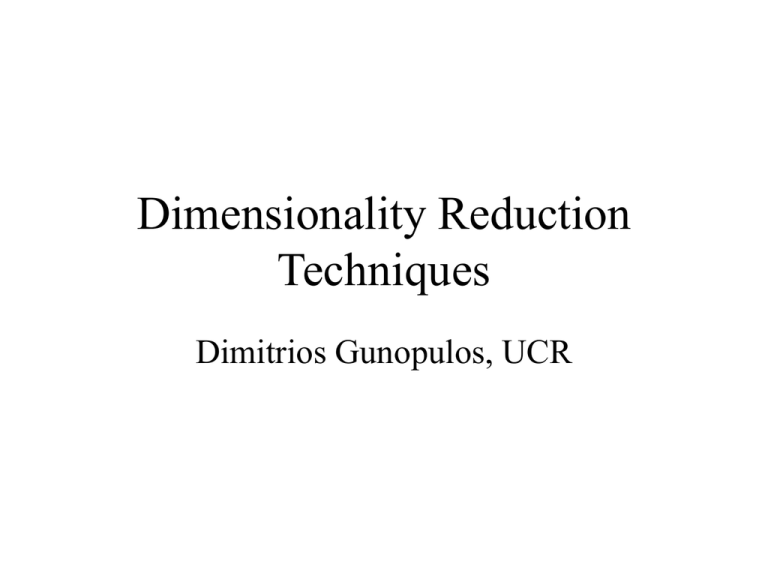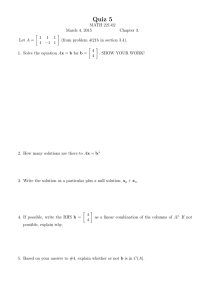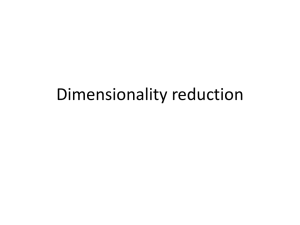SLIDES: Dimensionality Reduction Techniques
advertisement

Dimensionality Reduction Techniques Dimitrios Gunopulos, UCR Retrieval techniques for highdimensional datasets • The retrieval problem: – Given a set of objects S, and a query object S, – find the objectss that are most similar to S. • Applications: – financial, voice, marketing, medicine, video 2 Examples • Find companies with similar stock prices over a time interval • Find products with similar sell cycles • Cluster users with similar credit card utilization • Cluster products 3 Indexing when the triangle inequality holds • Typical distance metric: Lp norm. • We use L2 as an example throughout: – D(S,T) = (i=1,..,n (S[i] - T[i])2) 1/2 4 Indexing: The naïve way • Each object is an n-dimensional tuple • Use a high-dimensional index structure to index the tuples • Such index structures include – R-trees, – kd-trees, – vp-trees, – grid-files... 5 High-dimensional index structures • All require the triangle inequality to hold • All partition either – the space or – the dataset into regions • The objective is to: – search only those regions that could potentially contain good matches – avoid everything else 6 The naïve approach: Problems • High-dimensionality: – decreases index structure performance (the curse of dimensionality) – slows down the distance computation • Inefficiency 7 Dimensionality reduction • The main idea: reduce the dimensionality of the space. • Project the n-dimensional tuples that represent the time series in a k-dimensional space so that: – k << n – distances are preserved as well as possible 8 Dimensionality Reduction • Use an indexing technique on the new space. • GEMINI ([Faloutsos et al]): – Map the query S to the new space – Find nearest neighbors to S in the new space – Compute the actual distances and keep the closest 9 Dimensionality Reduction • A time series is represented as a k-dim point • The query is also transformed to the k-dim space query f2 dataset time f1 10 Dimensionality Reduction • Let F be the dimensionality reduction technique: – Optimally we want: – D(F(S), F(T) ) = D(S,T) • Clearly not always possible. • If D(F(S), F(T) ) D(S,T) – false dismissal (when D(S,T) << D(F(S), F(T) ) ) – false positives (when D(S,T) >> D(F(S), F(T) ) ) 11 Dimensionality Reduction • To guarantee no false dismissals we must be able to prove that: – D(F(S),F(T)) < a D(S,T) – for some constant a • a small rate of false positives is desirable, but not essential 12 What we achieve • Indexing structures work much better in lower dimensionality spaces • The distance computations run faster • The size of the dataset is reduced, improving performance. 13 Dimensionality Techniques • We will review a number of dimensionality techniques that can be applied in this context – – – – – – – SVD decomposition, Discrete Fourier transform, and Discrete Cosine transform Wavelets Partitioning in the time domain Random Projections Multidimensional scaling FastMap and its variants 14 SVD decomposition - the KarhunenLoeve transform • Intuition: find the axis that shows the greatest variation, and project all points into this axis f2 e1 e2 • [Faloutsos, 1996] f1 15 SVD: The mathematical formulation • Find the eigenvectors of the covariance matrix • These define the new space • The eigenvalues sort them in “goodness” order f2 e1 e2 f1 16 SVD: The mathematical formulation, Cont’d • Let A be the M x n matrix of M time series of length n • The SVD decomposition of A is: = U x L x VT, – U, V orthogonal – L diagonal • L contains the eigenvalues of ATA Mxn nxn nxn U x L x V 17 SVD Cont’d • To approximate the time series, we use only the k largest eigenvectors of C. • A’ = U x Lk • A’ is an M x k matrix X X' 0 20 40 60 80 100 120 140 eigenwave 0 eigenwave 1 eigenwave 2 eigenwave 3 eigenwave 4 eigenwave 5 eigenwave 6 eigenwave 7 18 SVD Cont’d • Advantages: – Optimal dimensionality reduction (for linear projections) • Disadvantages: – Computationally hard, especially if the time series are very long. – Does not work for subsequence indexing 19 SVD Extensions • On-line approximation algorithm – [Ravi Kanth et al, 1998] • Local diemensionality reduction: – Cluster the time series, solve for each cluster – [Chakrabarti and Mehrotra, 2000], [Thomasian et al] 20 Discrete Fourier Transform • Analyze the frequency spectrum of an one dimensional signal • For S = (S0, …,Sn-1), the DFT is: • Sf = 1/n i=0,..,n-1Si e-j2fi/n f = 0,1,…n-1, j2 =-1 • An efficient O(nlogn) algorithm makes DFT a practical method • [Agrawal et al, 1993], [Rafiei and Mendelzon, 1998] 21 Discrete Fourier Transform • To approximate the time series, keep the k largest Fourier coefficients only. • Parseval’s theorem: 2 S i=0,..,n-1 i = i=0,..,n-1Sf X X' 0 2 • DFT is a linear transform so: – i=0,..,n-1(Si-Ti)2 = i=0,..,n-1(Sf -Tf)2 20 40 60 80 100 120 140 0 1 2 3 22 Discrete Fourier Transform • Keeping k DFT coefficients lower bounds the distance: – i=0,..,n-1(S[i]-T[i])2 > i=0,..,k-1(Sf -Tf)2 • Which coefficients to keep: – The first k (F-index, [Agrawal et al, 1993], [Rafiei and Mendelzon, 1998]) – Find the optimal set (not dynamic) [R. Kanth et al, 1998] 23 Discrete Fourier Transform • Advantages: – Efficient, concentrates the energy • Disadvantages: – To project the n-dimensional time series into a kdimensional space, the same k Fourier coefficients must be store for all series – This is not optimal for all series – To find the k optimal coefficients for M time series, compute the average energy for each coefficient 24 Wavelets • Represent the time series as a sum of prototype functions like DFT • Typical base used: Haar wavelets • Difference from DFT: localization in time • Can be extended to 2 dimensions • [Chan and Fu, 1999] • Has been very useful in graphics, approximation techniques 25 Wavelets • An example (using the Haar wavelet basis) – S (2, 2, 7, 9) : original time series – S’ (5, 6, 0, 2) : wavelet decomp. – S[0] = S’[0] - S’[1]/2 - S’[2]/2 – S[1] = S’[0] - S’[1]/2 + S’[2]/2 – S[2] = S’[0] + S’[1]/2 - S’[3]/2 – S[3] = S’[0] + S’[1]/2 + S’[3]/2 • Efficient O(n) algorithm to find the coefficients 26 Using wavelets for approximation • Keep only k coefficients, approximate the rest with 0 • Keeping the first k coefficients: – equivalent to low pass filtering • Keeping the largest k coefficients: – More accurate representation, But not useful for indexing X X' 0 20 40 60 80 100 120 140 Haar 0 Haar 1 Haar 2 Haar 3 Haar 4 Haar 5 Haar 6 Haar 7 27 Wavelets • Advantages: – The transformed time series remains in the same (temporal) domain – Efficient O(n) algorithm to compute the transformation • Disadvantages: – Same with DFT 28 Line segment approximations • Piece-wise Aggregate Approximation – Partition each time series into k subsequences (the same for all series) – Approximate each sequence by : • its mean and/or variance: [Keogh and Pazzani, 1999], [Yi and Faloutsos, 2000] • a line segment: [Keogh and Pazzani, 1998] 29 Temporal Partitioning • Very Efficient technique (O(n) time algorithm) • Can be extended to address the subsequence matching problem • Equivalent to wavelets (when k= 2i, and mean is used) X X' 0 20 40 60 80 100 120 140 x0 x1 x2 x3 x4 x5 x6 x7 30 Random projection • Based on the Johnson-Lindenstrauss lemma: • For: – 0< e < 1/2, – any (sufficiently large) set S of M points in Rn – k = O(e-2lnM) • There exists a linear map f:S Rk, such that – (1-e) D(S,T) < D(f(S),f(T)) < (1+e)D(S,T) for S,T in S • Random projection is good with constant probability • [Indyk, 2000] 31 Random Projection: Application • • • • Set k = O(e-2lnM) Select k random n-dimensional vectors Project the time series into the k vectors. The resulting k-dimensional space approximately preserves the distances with high probability • Monte-Carlo algorithm: we do not know if correct 32 Random Projection • A very useful technique, • Especially when used in conjunction with another technique (for example SVD) • Use Random projection to reduce the dimensionality from thousands to hundred, then apply SVD to reduce dimensionality farther 33 Multidimensional Scaling • Used to discover the underlying structure of a set of items, from the distances between them. • Finds an embedding in k-dimensional Euclidean that minimizes the difference in distances. • Has been applied to clustering, visualization, information retrieval… 34 Algorithms for MS • Input: M time series, their pairwise distances, the desired dimensionality k. • Optimization criterion: stress = (ij(D(Si,Sj) - D(Ski, Skj) )2 / ijD(Si,Sj) 2) 1/2 – where D(Si,Sj) be the distance between time series Si, Sj, and D(Ski, Skj) be the Euclidean distance of the kdim representations • Steepest descent algorithm: – start with an assignment (time series to k-dim point) – minimize stress by moving points 35 Multidimensional Scaling • Advantages: – good dimensionality reduction results (though no guarantees for optimality • Disadvantages: – How to map the query? O(M) obvious solution.. – slow conversion algorithm 36 FastMap [Faloutsos and Lin, 1995] • Maps objects to k-dimensional points so that distances are preserved well • It is an approximation of Multidimensional Scaling • Works even when only distances are known • Is efficient, and allows efficient query transformation 37 How FastMap works • Find two objects that are far away • Project all points on the line the two objects define, to get the first coordinate • Project all objects on a hyperplane perpendicular to the line the two objects define • Repeat k-1 times 38 MetricMap [Wang et al, 1999] • Embeds objects into a k-dim pseudo-metric space • Takes a random sample of points, and finds the eigenvectors of their covariance matrix • Uses the larger eigenvalues to define the new kdimensional space. • Similar results to FastMap 39 Dimensionality techniques: Summary • • • • SVD: optimal (for linear projections), slowest DFT: efficient, works well in certain domains Temporal Partitioning: most efficient, works well Random projection: very useful when applied with another technique • FastMap: particularly useful when only distances are known 40 Indexing Techniques • We will look at: – R-trees and variants – kd-trees – vp-trees and variants – sequential scan • R-trees and kd-trees partition the space, vp-trees and variants partition the dataset, there are also hybrid techniques 41 R-trees and variants [Guttman, 1984], [Sellis et al, 1987], [Beckmann et al, 1990] • • • • k-dim extension of B-trees Balanced tree Intermediate nodes are rectangles that cover lower levels Rectangles may be overlapping or not depending on variant (R-trees, R+-trees, R*-trees) • Can index rectangles as well as points L1 L2 L4 L5 L3 42 kd-trees • • • • Based on binary trees Different attribute is used for partitioning at different levels Efficient for indexing points External memory extensions: hB-tree f1 f2 43 Grid Files • Use a regular grid to partition the space • Points in each cell go to one disk page • Can only handle points f2 f1 44 vp-trees and pyramid trees [Ullmann], [Berchtold et al,1998], [Bozkaya et al1997],... • Basic idea: partition the dataset, rather than the space • vp-trees: At each level, partition the points based on the distance from a center • Others: mvp-, TV-, S-, Pyramid-trees c3 c2 R1 c1 The root level of a vp-tree with 3 children R2 45 Sequential Scan • The simplest technique: – Scan the dataset once, computing the distances – Optimizations: give lower bounds on the distance quickly – Competitive when the dimensionality is large. 46 High-dimensional Indexing Methods: Summary • For low dimensionality (<10), space partitioning techniques work best • For high dimensionality, sequential scan will probably be competitive with any technique • In between, dataset partitioning techniques work best 47 Open problems • Indexing non-metric distance functions • Similarity models and indexing techniques for higherdimensional time series • Efficient trend detection/subsequence matching algorithms 48



